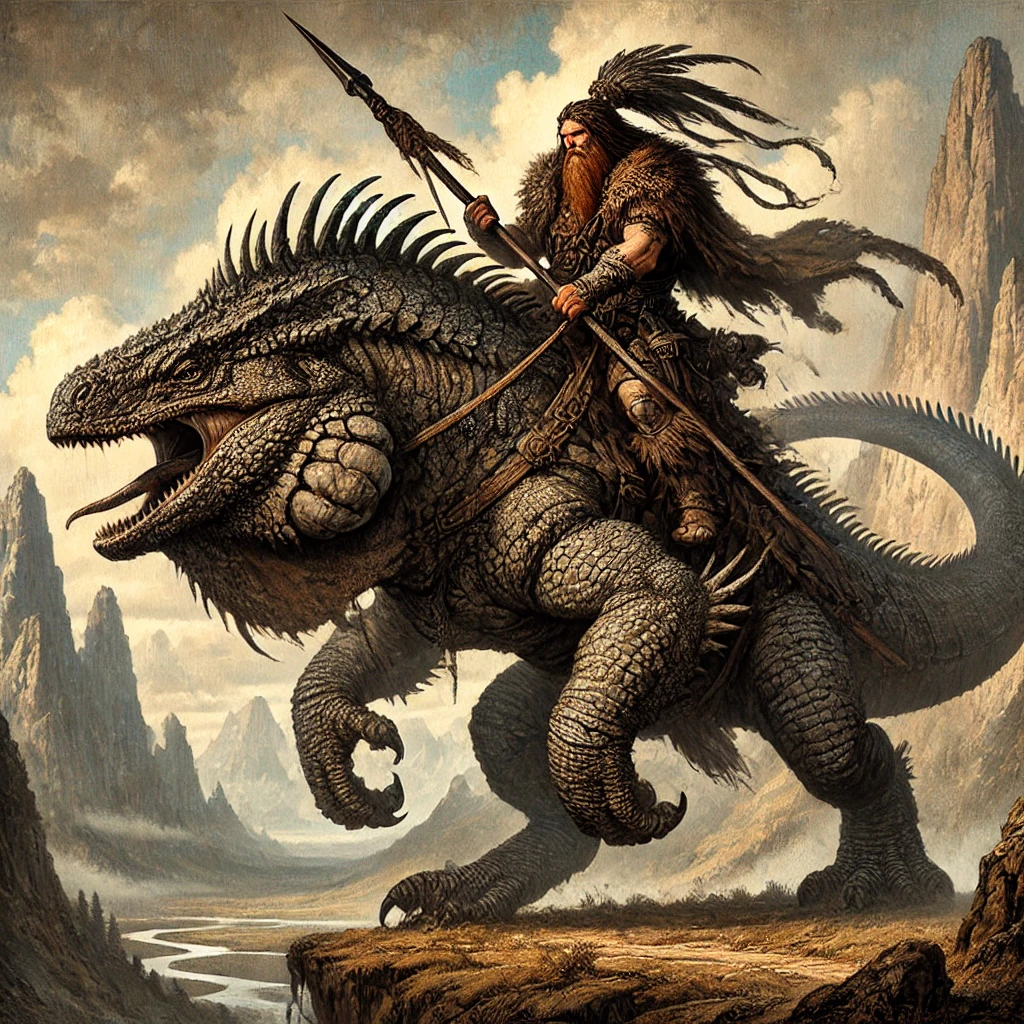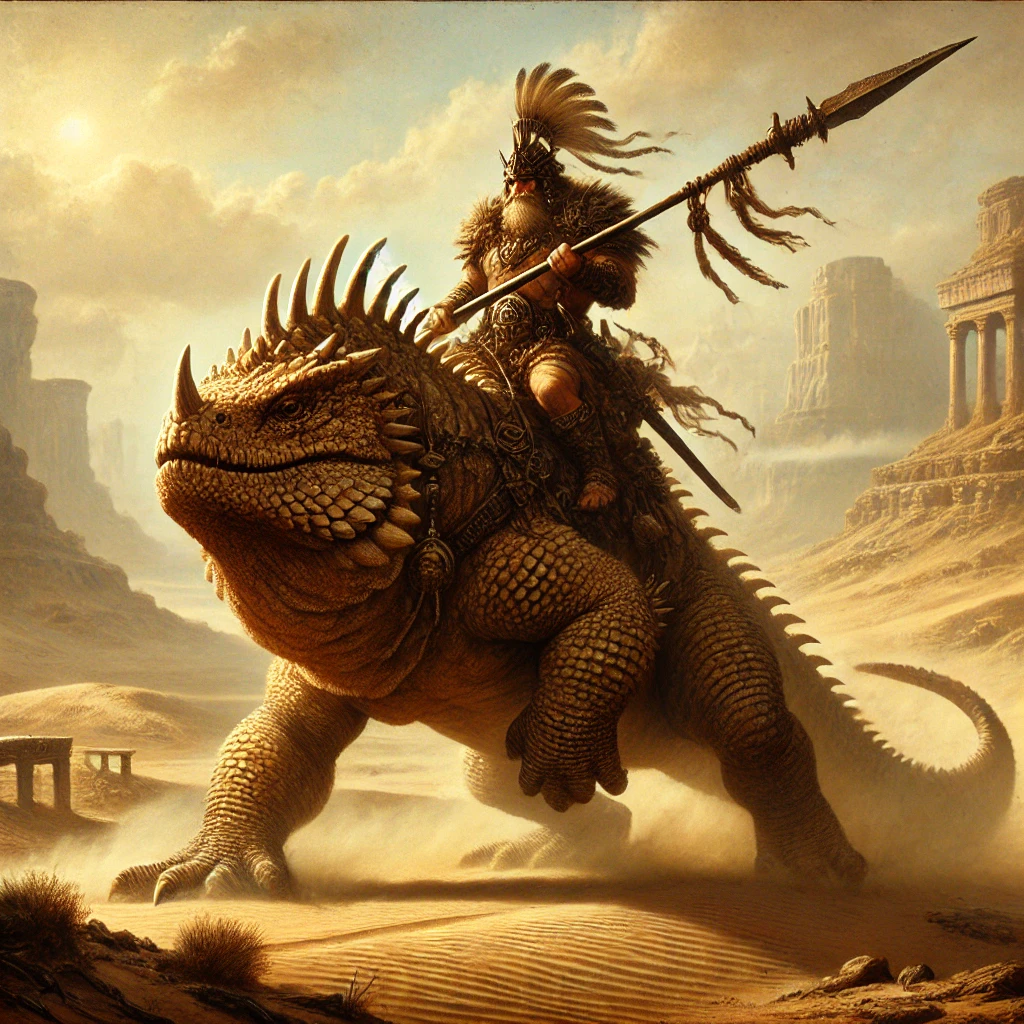Giant Riding Lizard
Riding lizards are a diverse family of large reptilian creatures that serve as popular and practical mounts. They come in various variations, each adapted to specific environments. Riding lizards are substantial in size, typically ranging from 7 to 12 feet in length. Their impressive stature provides ample space for riders and gear.
These creatures are known for their even-tempered and cooperative dispositions, making them suitable companions for riders of all levels of experience. However, the temperament may vary depending on the specific lizard variation.
Riding lizards have become a vital part of life in regions with extreme climates or difficult terrain, where traditional mounts would struggle. They are seen not only as practical transportation but also as symbols of resilience and adaptation. In some cultures, riding lizards are given ceremonial adornments or markings, honoring their role as companions and protectors.
Overall, riding lizards offer a unique blend of adaptability, strength, and cooperation, making them invaluable assets for anyone journeying through the challenging landscapes of Tanaria.
Desert Strider
The Desert Strider is a massive, ridable lizard, derived from the whiptail's lineage and adapted to desert environments. Desert Striders are renowned for their long, whip-like tails that can reach impressive lengths of up to 15 feet (3.7 meters). These tails are used for balance and, occasionally, defense. They have tough, scaly skin, which comes in various shades of earthy colors like sand, clay, and pale desert hues, providing excellent natural camouflage. Desert Striders are primarily herbivorous, feeding on hardy desert vegetation, succulent plants, and occasional insects. They can go for extended periods without water, relying on their ability to conserve moisture. Desert Striders are known for their even-tempered and calm disposition, which makes them ideal companions for desert travelers. Their demeanor is well-suited for riders of all levels of experience. These creatures exhibit impressive speed and endurance. Their powerful legs are built for sprinting across the desert's unforgiving terrain. With proper care and conditioning, they can sustain their pace for extended periods.Inferno Scourge
A rare and fierce variation of the Desert Strider, the Inferno Scourge is known for its distinctive, horned appearance and association with infernal regions. Inferno Scourges have prominent, horn-like bony protrusions on their heads and along their backs. These fiery red or orange markings stand out dramatically against their desert-hued scales. They are often associated with volcanic regions, where they have adapted to extreme heat and environmental conditions.Forest Stalker
The Forest Stalker is a giant lizard descended from the reptilian beasts of the underdark, adapted to life in the lush rainforests and dense forests. Forest Stalkers are omnivorous, feeding on a diet of vegetation, small mammals, insects, and even the occasional bird. Their adaptability in terms of diet allows them to thrive in diverse forest ecosystems. Forest Stalkers have a stocky, muscular build with mottled, camouflaged skin in various shades of green, making them blend seamlessly into the forest's foliage. Their powerful, prehensile tails are used for balance and navigating through the dense undergrowth. Forest Stalkers are known for their inquisitive and cautious nature. They possess a strong sense of curiosity, often exploring their lush surroundings. They require experienced riders who can handle their keen senses and occasional boldness. These creatures may not match the sprinting speed of their desert counterparts, but they excel in agility and endurance. They navigate through dense forests with ease, using their powerful limbs to climb trees and move gracefully through underbrush.Swamp Crawler
The Swamp Crawler is a large, resilient riding lizard adapted to marshy, swampy environments. With water-resistant, dark greenish-brown scales and muscular, broad feet, it can easily navigate through mud and shallow water, making it invaluable in swamp regions where other mounts would struggle. Known for its even temperament and strong endurance, the Swamp Crawler is a reliable choice for travel through wetland areas. Swamp Crawlers are slower than Desert Striders and Forest Runners, which excel in flat, open terrain and densely forested areas, respectively, but compensate with a much faster swim speed, allowing them to move efficiently through swamps and wetlands where other lizards might falter. Swamp Crawlers have a calm, almost placid temperament, making them cooperative and low-maintenance for handlers, likely due to fewer natural threats in swamp environments. This easy-going disposition makes them popular mounts for explorers or traders needing reliable transportation through swamp regions.Basic Information
Anatomy
Riding lizards exhibit thick, muscular builds with long, powerful limbs that allow for speed and stability. Their tails are often sturdy and used for balance while maneuvering through challenging landscapes. Depending on the environment they inhabit, their scales may range from rough and thick, offering protection against harsh climates, to smooth and flexible, allowing for better agility in dense forests. They have elongated, agile bodies designed to carry significant weight while maintaining stability on uneven terrain.
Most variations of riding lizards possess clawed feet suited to climbing or gripping loose soil, rocky outcroppings, and even vertical surfaces in more extreme environments. Their sharp eyesight and strong sense of smell allow them to detect threats or prey from a distance, adding an extra layer of security for their riders.
Dietary Needs and Habits
Riding lizards are adaptable in terms of diet, with their preferences largely shaped by their natural habitat. Desert Striders are often omnivorous, feeding on sparse desert vegetation, insects, and small prey like lizards or rodents. Forest Runners and Mountain Climbers tend to be more herbivorous, consuming a mix of leaves, grasses, and small fruits, while Swamp Crawlers are opportunistic feeders, consuming whatever plant matter, insects, or small aquatic creatures are available.
Their dietary flexibility is essential to their survival across different terrains, as they can sustain themselves on a wide variety of foods. In captivity, handlers feed them a mix of fresh greens, fruits, and proteins as needed, ensuring a balanced diet that meets their unique nutritional requirements.
Additional Information
Domestication
Riding lizards are generally even-tempered, with a calm disposition that makes them suitable for riders of varying experience levels. However, specific temperaments may differ depending on the variation and the environment in which they are raised. Desert Striders, for instance, are known for their patience and calmness under extreme heat, while Mountain Climbers can be more cautious and observant, carefully considering each step on treacherous terrain.
Training a riding lizard is a gradual process, involving early familiarization with humans and desensitization to carrying weight. Due to their intelligence and strong memory, trained riding lizards are loyal to their handlers, able to recognize familiar people and even respond to basic verbal commands. Riders often use subtle pressure cues or reins to guide them, but experienced handlers may forgo these altogether, relying on their lizard’s natural instincts to navigate difficult paths.
Geographic Origin and Distribution
All continents, Desert, Rainforests, Active Volcanoes










Comments